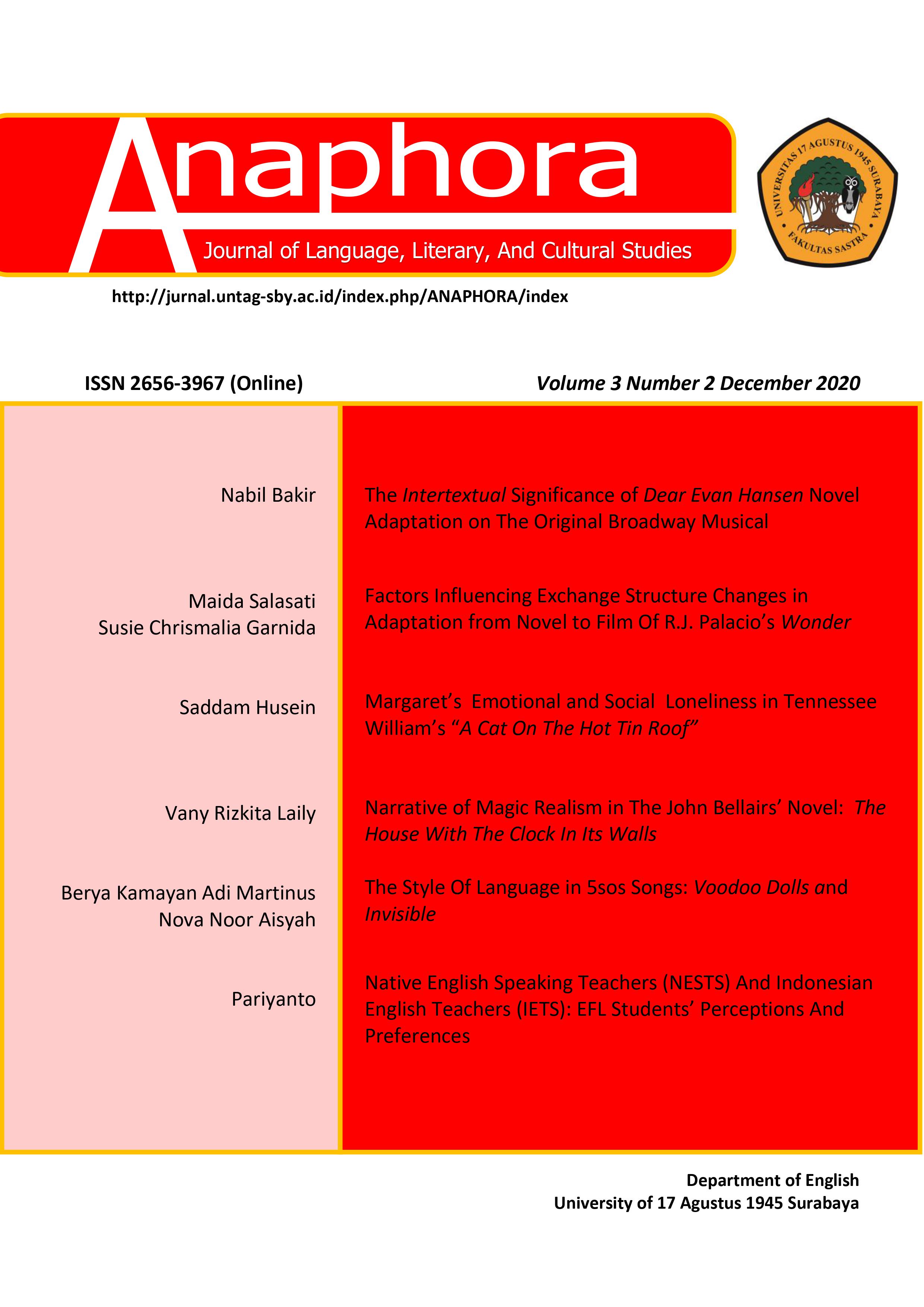NATIVE ENGLISH SPEAKING TEACHERS (NESTs) AND INDONESIAN ENGLISH TEACHERS (IETs) EFL STUDENTS’ PERCEPTION AND PREFERENCES
DOI:
https://doi.org/10.30996/anaphora.v3i2.4620Keywords:
NESTs, NNESTs, IETs, EFL Learners, PerceptionAbstract
This paper explores EFL students’ perception of Indonesian English Teachers (IETs)/ Non-Native English Speaking Teachers (NNESTs) and Native English Speaking Teachers (NESTs) in English Language Teaching (ELT) in Indonesia. 32 Indonesian EFL university students participated in this study. Employing a five-point Likert scale questionnaire (1= strongly disagree, 2= disagree, 3= neutral, 4= agree, 5= strongly agree) distributed to participants, this study found that (1) students perceived IETs/NNESTs to be better in teaching beginning learners as IETs/NNESTs apply Indonesian into English instruction, sharing the same first language and the same culture, understanding students’ problem in learning English, understanding the questions and providing clear answers, and sharing the same language learning process; (2) students perceived NESTs to be better in teaching advanced learners of English as NESTs are superior in their English proficiency. NESTs are perceived to better in teaching speaking, pronunciation, listening, and culture. This study implies that both IETs/NNSTs and NESTs have their strengths and weaknesses in the English language teaching context.
Downloads
References
Bachrudin, M. (2001). Communicative language teaching in Indonesia: issues of theoretical assumptions and challenges in the classroom practice. English Quarterly, 33(2), 63.
Brown, H. D. (2007a). Principles of language learning and teaching (5th ed.). New York: Pearson Longman.
Brown, H. D. (2007b). Teaching by principle: an interactive approach to language pedagogy (3rd ed.). New York: Pearson education , Inc.
Canagarajah, A. S. (1999). Interrogating the "native speaker fallacy": non-linguistic roots, non-pedagogical results. . In G. Braine (Ed.), Non-native educators in English language teaching (pp. 77-92). Mahwah: Lawrence Erlbaum Associates.
Chodidjah, I. (n.d.). English in Primary Schools: gem in the mud. Surabaya: British Council Indonesia.
Cortazzi, M., & Jin, L. (1996). Cultures of learning: language classrooms in China, section Chinese views of western teaching. In H. Coleman (Ed.), Society and the language classroom (pp. 192-194). Cambridge: Cambridge University Press.
Dornyei, Z. (2001). Motivational strategies in the language classroom. Cambridge: Cambridge University Press.
Ellis, R. (1997). SLA research and language teaching. Oxford: Oxford University Press.
Han, S.-A. (2005). Good teachers know where to scratch when learners feel itchy: Korean lerners' views on native speaking teachers of English. Australian Journal of Education, 49(2), 197-213.
Mayer, R. E. (2003). Learning and instruction. New Jersey: Merril Prentice Hall.
McKay, S. L. (2002 ). Teacing English as an intenational language: rethinking goals and approaches. Oxford: Oxford University Press.
Medgyes, P. (2006). When the teacher is a non-native speaker. In M. Celce-Murcia (Ed.), Teaching English as a second or foreign language. Beijing: Foreign language teaching and research press.
Sudibyo, B. (2008). Peraturan menteri pendidikan nasional nomor 78 tahun 2008. Retrieved 1 october 2009. from http://www.depdiknas.go.id/.
Suyanto, K. E. (n.d.). Pengajaran Bahasa Inggris di Sekolah Dasar: kebijakan, implementasi, dan kenyataan.Unpublished manuscript, Malang.
Yule, G. (2006). The study of language (3rd ed.). Cambridge: Cambridge University Press.
Downloads
Published
How to Cite
Issue
Section
License
Authors whose manuscript is published will approve the following provisions:
-
The right to publication of all journal material published on the jurnal anaphora website is held by the editorial board with the author's knowledge (moral rights remain the property of the author).
-
The formal legal provisions for access to digital articles of this electronic journal are subject to the terms of the Creative Commons Attribution-ShareAlike (CC BY-SA) license, which means Jurnal Persona reserves the right to store, modify the format, administer in database, maintain and publish articles without requesting permission from the Author as long as it keeps the Author's name as the owner of Copyright.
-
Printed and electronic published manuscripts are open access for educational, research and library purposes. In addition to these objectives, the editorial board shall not be liable for violations of copyright law.















